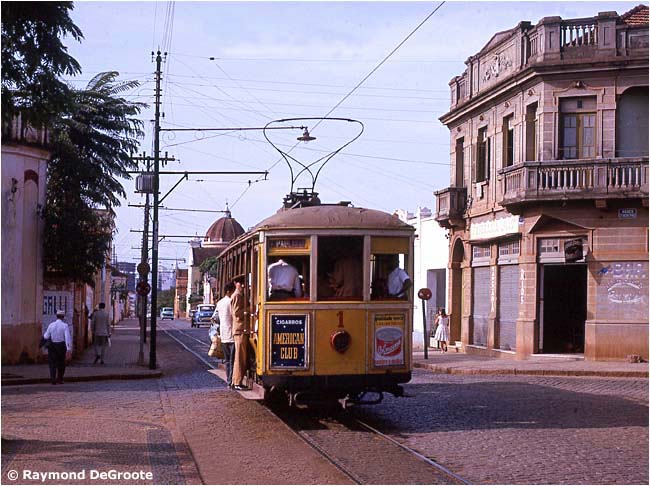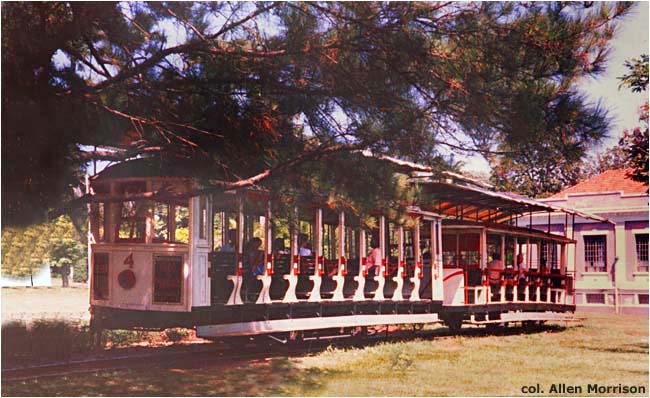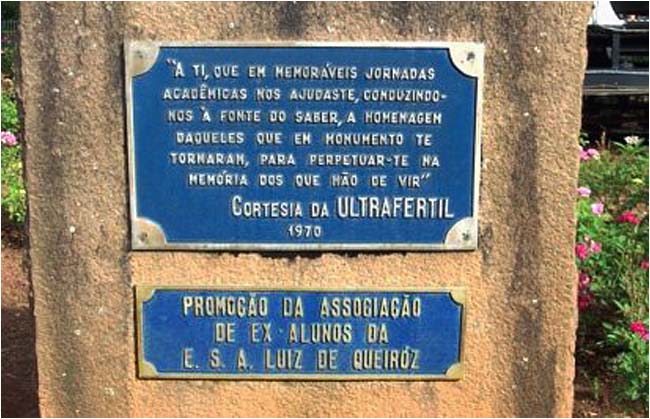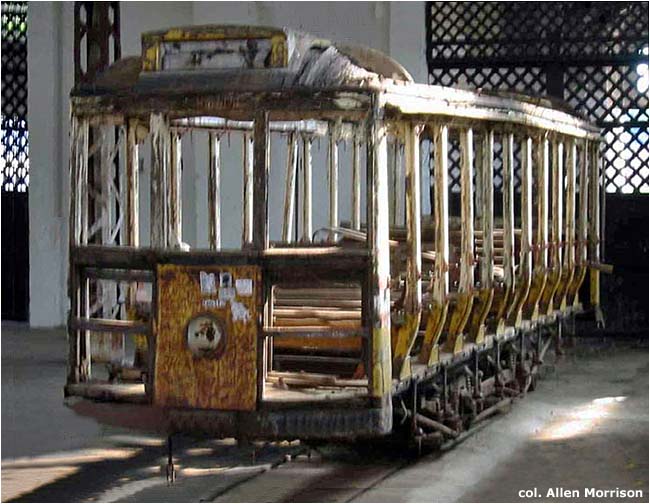The Trams of / Os Bondes de BY Brazil's native Tupi people called it "pirá-syk-aba"– the place where the fish stop – because of the rapids on the river that runs through it [see photo]. Piracicaba is a small city 184 km northwest of São Paulo (city) and 79 km from Campinas [see 1977 railroad map]. It is one of several towns in Brazil that operated only electric trams, never had a horsecar line. Piracicaba is a center of the sugar and coffee industries and famous for its agriculture school, one of the largest in Brazil and now part of Universidade de São Paulo. The city's population was about 40,000 in 1910, is 370,000 today. The Ituana Railroad arrived in 1877 and built a station in the center of town. The Engenho Central sugar mill, established on the other side of the river in 1881, built a steam-powered "tramway" along the river to its plantations north of town [see 1901 map]. But this was not a tramway in the English language sense: tramway in Brazil usually means industrial railway. There was no need for urban transportation in Piracicaba until the Escola de Agricultura Luiz de Queiroz opened its campus northeast of town in 1901. Between that date and 1914 there were at least nine proposals for animal, steam and electrically powered street railway lines. One plan involved a 35-km "linha de bonds eletricos ou a vapor" – electric or steam-powered line – between Piracicaba and the neighboring city of Rio Claro [see 1910 article]. All these projects were rejected by the Piracicaba municipal government. Electric trams had been running in Rio de Janeiro since 1892 and in São Paulo (city) since 1900. Campinas opened its first line in 1912 and São Carlos inaugurated its electric system in 1914 [see railroad map]: The electric tramway that the Empresa Electricidade de Piracicaba proposed in 1913 was ignored until E.E.P. formed an alliance with Southern Brazil Electric Co., organized that year in London. E.E.P. renewed its offer in 1914 and was approved on 30 September 1915. Construction began in October and four open trams were acquired from the Campinas system in December. They were from that city's original fleet of eight cars built by J. G. Brill Co. in Philadelphia in 1912. The photograph below, taken in Philadelphia, shows car number 1 [Brill Magazine, 7/1912: see BIBLIOGRAPHY]:
The vehicles from Campinas were of a classic bi-directional design, with six reversible benches in the center and two fixed benches at each end. Track gauge of the Piracicaba tramway, as of the Campinas lines (and also the Ituana Railroad, which became part of the Sorocabana system in 1905), was one meter. The first tram garage was on Rua Morais Barros. Empresa Eletrica (de) Piracicaba opened its first tram line, from Praça da Catedral to the "Agronomia", on 15 January 1916 [see map]. This undated photograph shows car 5. Apparently Campinas did not send them in sequence [col. AM]:
The route to the agriculture school was E.E.P.'s only tram line for five years. On 6 December 1921 it opened a new line that crossed the river to "Vila Rezende" and on 30 July 1922 a third line down Rua Boa Morte to "Estação Paulista" – the new station of the Paulista Railroad, which opened its 1600 mm gauge line to Piracicaba that year [see map]. E.E.P. also replaced its garage on Rua Morais Barros with a new one on Av. Dr. Paulo de Morais, a few blocks east of the station. There was a plan to extend the track north and east to the Cidade Alta [see map], but the project was never realized. The photograph below shows a car turning from Rua Boa Morte onto Av. Dr. Paulo de Morais. The Paulista station is visible through the arch [col. Wanderley Duck]:
At some point the inscriptions "Empresa Elétrica de Piracicaba" and "E.E. Piracicaba" on the cars were replaced by "Southern Brazil Electric Co." or "S.B.E.C." The next view is south on Rua Boa Morte toward the Paulista station [see map]. The imposing structure on the hill belongs to the Colégio Salesiano Dom Bosco. The Piracicaba cathedral is out of sight, behind the photographer [col. Wanderley Duck]:
The physical layout of the Piracicaba tramway was primitive and did not expand to serve the growing city. The Vila Rezende line had a passing siding, but the other two lines consisted entirely of single track, which meant that there could be only one car in service at a time [see map]. If a passenger missed it, (s)he had to wait until it made a complete round trip of its circuit before it passed again. Southern Brazil Electric, which supplied both electricity and tramway service to Piracicaba, was acquired by the U.S. conglomerate Electric Bond and Share Co. in 1929. "Ebasco" brought another tram from Campinas, but its main interest was electric power and it did little to improve tramway operation. Annoyed by such Yankee indifference, the students at the university set a tram on fire in 1932. In 1933 the new owners began returning the Piracicaba cars to Campinas for remodeling. Companhia Campineira removed their clerestories, enclosed the platforms at each end and altered the seating arrangements. The vehicles themselves were improved, but tramway service was still infrequent, and buses provided better transportation. The trams kept running, and the 1945 survey of the Instituto Brasileiro de Georgrafia e Estatística reported 27 employees, 5 passenger motor cars, 1 passenger trailer and 8 km of meter-gauge tramway track in Piracicaba. The system was transferred to the Prefeitura (municipal government) in 1950. When North American tramway enthusiasts discovered the Piracicaba system at mid-century they nicknamed it "the Ft. Collins of South America" because of its resemblance to the tramway system in that small city in Colorado, where three cars served three lines and met downtown every hour. The photographs below were taken in the 1950s and 60s, most by U.S. tramway enthusiasts Earl W. Clark and Raymond DeGroote in 1963. The first shows trailer car 1 and motor cars 1 and 3 in the depot on Av. Dr. Paulo de Morais [see map] [Earl W. Clark]: |

The second picture shows the tramway depot from the other side of Av. Dr. Paulo de Morais, where cars on the "Estação Paulista" route finished their run [see map]. These structures survive almost unchanged today [see Google "Street View"]. The rails and ties in the foreground may be remnants of the planned extension [Earl W. Clark]: |

Between the tram depot and the Estação Paulista the cars ran alongside Av. Dr. Paulo de Morais, next to the embankment of the Paulista Railroad [see map] [Raymond DeGroote]: |

Tram number 1 was unique on the Piracicaba system in that it had only five reversible benches in the center, in addition to the double seats at each end. Compare to the tram in the first picture on this page. Since Brill is not known to have supplied vehicles this way, number 1 was probably built by the tramway company in Campinas [Raymond DeGroote]:
|

Trams 3 and 1 at the passing siding on Rua Campos Sales [see map]. This was the only place on the system where two cars traveling in opposite directions could pass. The view is east. The two-story structure on the right is still there today, but the house on the left has been replaced by commercial buildings [Earl W. Clark]: |

A better view of tram 3 with the same passengers, but taken a few seconds later, after car 1 had departed [Earl W. Clark]:
Another view of tram 3 on the bridge [Raymond DeGroote]:
|

After reconstruction Piracicaba tram 2, shown below, retained its original Brill layout with six reversible benches and back-to-back seating at the ends. This photograph was taken in 1965 at Praça da Catedral at the corner of Ruas Boa Morte and XV de Novembro, the junction where the three lines met [see map]. The view is east. The cathedral is behind those trees [Foster M. Palmer]:
|

The Agronomia, the other end of the line at the Escola Superior de Agricultura Luiz de Queiroz [see map]. The car will wait here, flip over its seatbacks, gather passengers, then return to the city [Earl W. Clark]:
|

The same spot on Rua José Soledade in Vila Rezende as shown in the picture above. This is another photograph that shows all three meter-gauge rail lines: the electric tramway, the Sorocabana Railroad and the track of what the 1901 map calls the Tramway do Engenho Central. The rails of the industrial railway were intact when this photograph was taken in April 1963 [col. www.tra.ms]:
|

ESALQ ended all tramway service on 3 October 1969. (The Campinas tramway had closed in 1968.) ESALQ placed motor car 4 and trailer 1 on display on the campus. The trams became favorite places for students to sit and reminisce... [col. AM]:
"To you [the tramway], who helped us in our memorable school days, leading us to the source of knowledge, the homage of those who turned you into a monument, so as to perpetuate you in the memory of those who have yet to come . . . A tribute by the Alumni Association of ESALQ" Tram 3 ended up across the river at the Engenho Central. The sugar mill closed in 1974, but the car remains inside one of its deserted buildings to this day. A 1998 plan to rehabilitate the car and run it on a tourist line along the river has not developed [col. AM]:
Electric tram cars ran in Piracicaba for 53 years. Car 4, displayed at the university since 1969, and recently renumbered 2, was 100 years old in 2012. The former Sorocabana Railroad ended passenger service in 1976, the Paulista line in 1977. The former's right-of-way through the city is now a multi-lane highway. The Paulista rails remain.
BIBLIOGRAPHY Untitled news item in Brazil-Ferro-Carril (Rio de Janeiro), 1910 [precise date and page number unknown]. Plan for electric or steam tramway between Piracicaba and Rio Claro. "Initial Equipment for Campinas, Brazil" in Brill Magazine [Philadelphia], VII 1912, pp. 218-221. Description and three illustrations of the city's first electric trams – five of which were transferred to Piracicaba. Piracicaba, Câmara Municipal. Contracto com "The Southern Brazil Electric Co." para a Installação de Tramways Electricos. Piracicaba, 10 IX 1915. Contract to build electric tramway. "Open Cars for Campinas, Brazil" in Brill Magazine [Philadelphia], XII 1916. pp. 372-373. Description of the city's second tram model. A paragraph on p. 373 notes that four cars from the earlier group were sent to, and were then running in, Piracicaba. Instituto Histórico e Geográfico de Piracicaba. "Piracicaba", 6-minute film, 1922. Extraordinary scenes of trams and trains – both railroads – in Piracicaba in 1922! Fundação IBGE - Instituto Brasileiro de Geografia. Carta do Brasil - Escala 1:50,000, 1969. Folha SF-23-M-III-2 "Piracicaba". Excellent medium-scale map of the Piracicaba area. "Bondes" in Jornal de Piracicaba (Piracicaba), 8 X 1969, p. 1. Tramway closure. S. de Toledo Piza Jr. "O Bondinho da Escola Agrícola" in ESALQ 75: Livro comemorativo do 75° aniversário da Escola Superior de Agricultura Luiz de Queiroz, da Universidade de São Paulo. Piracicaba, 1976. Sentimental tribute to the tramway era. No data. Waldemar Corrêa Stiel. História dos Transportes Coletivos em São Paulo. São Paulo, 1978. The "Piracicaba" chapter on pp. 300-304 presents impressive detail on early tramway plans. There are six interesting photographs. Waldemar Corrêa Stiel. História do Transporte Urbano no Brazil. Brasília, 1984. The author's "Piracicaba" chapter on pp. 246-248 of this volume is much shorter, but contains two nice illustrations. As in the earlier work, the tramway operator Southern Brazil Electric Co. is mistakenly called South Brazil Electric Co. Renato Feliciano Dias, Ligia Maria Martins Cabral, Paulo Brandi. Panorama do setor de energia elétrica no Brasil. Rio de Janeiro, 1988. The Southern Brazil Electric Co. in Piracicaba, p. 47. Allen Morrison. The Tramways of Brazil: A 130-Year Survey. New York, 1989. "Piracicaba" chapter, pp. 152-154. Brief history, map, three photographs. João Umberto Nassif, Rádio Educadora de Piracicaba. Programa Piracicaba Histórias e Memórias. Transcription of interview with Piracicaba tram conductor Anésio de Souza, 2 III 2002. João Lucio Azevedo Filho. Old Street Car at ESALQ. Flickr page with nine black/white photographs taken on 27 XII 2011 of the two trams displayed at the agriculture school. Car "2" was numbered "4" when it ran in Piracicaba. Ralph Mennucci Giesbrecht. Estações Ferroviárias do Brasil. History, maps and photographs of the Paulista Railroad's station at Piracicaba, the Sorocabana Railroad's station at Piracicaba, and the latter's station at Barão de Rezende (Vila Rezende).
The author wishes to express his gratitude to Earl W. Clark, Raymond DeGroote, the late William C. Janssen, Wanderley Duck and Ayrton Camargo e Silva for the assistance, information and illustrations that they provided for this page.
_______________________________________
Ver Also see and and my index of If you have comments, criticism or suggestions, This site was placed online on 17 October 2012 Copyright © 2012-2112 Allen Morrison As fotos coloridas desta página são protegidas pela Lei do Direito Autoral (Lei N° 9.610 de 19 de Fevereiro de 1998) e não podem ser reproduzidas sem a expressa autorização do autor. |



















